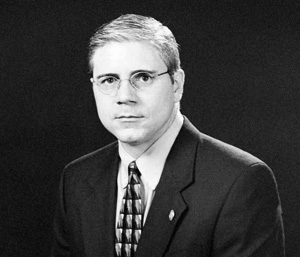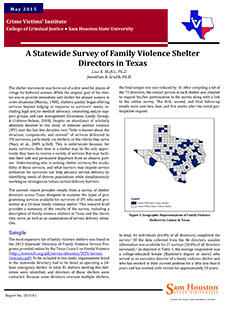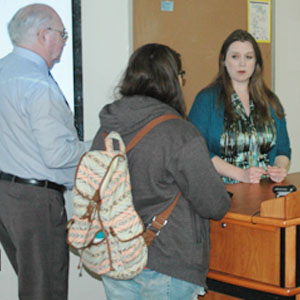In 2001, the College of Criminal Justice launched the inaugural master’s degree for forensic science in Texas, and it is making history again by offering the first multi-disciplinary Ph.D. in the field in the country.
The interdisciplinary curriculum at SHSU prepares students for a wide variety of forensic science disciplines including DNA, toxicology, firearms, drugs, trace evidence, latent prints, questioned documents or arson. Despite the competitive nature of the field, employment and post graduate success rates have averaged 96 percent since 2006. The majority of graduates work in the public sector, in federal, state, county and city crime labs and medical examiner’s offices, but others have turned to private lab or advanced degrees.
“Sam Houston’s Forensic Science Program helped me to achieve my goal of becoming a forensic scientist by providing the essential knowledge, guidance and skills needed for everyday life in a real-world crime lab,” said Anna Mudd, Supervisor of the Toxicology Section of the Texas Department of Public Safety Crime Lab.
The College also recently introduced undergraduate minors in forensic science and forensic anthropology, which can help boost career options in criminal justice, natural sciences and the health care field.
“If you understand a little more about forensic science, it will help you be a better investigator,” said Dr. Sarah Kerrigan, Director of the Department of Forensic Science and former state crime lab director. “It will also make individuals with science degrees more competitive if they choose to pursue a career in forensics with just a BS degree.”
With federal changes on the horizon for the possible certification of forensic scientists, the Department recently added the Institute for Forensic Research, Training and Innovation (IFRTI), which will train professionals to meet current and future standards in forensic science disciplines an build partnerships between academia and crime labs to address issues or trends in the field. In addition to forensic scientists, the program will serve a wide variety of criminal justice professionals, including educators, scientists, law enforcement, attorneys and the judiciary.
“With forensic science reform pending in Congress, institutes of higher education are expected to play a major role in terms of research and training,” said Dr. Kerrigan, Chair of the Department of Forensic Science. “These improvements in the broad field of forensics present a unique opportunity to enhance our profile and national standing, while making a significant contribution to the advancement of efforts at the national level.”
The College of Criminal Justice and the College of Arts and Sciences at SHSU collaborated to create the program in 2001. In 2006, the program underwent a major overhaul, including the introduction of almost a dozen new courses, hiring new faculty, relocation to a state-of-the art Chemistry and Forensic Sciences Building, and investment in scientific equipment found in crime labs.
Now with its own Department, new equipment and a Ph.D. degree, the program is set to take on the future of the field
“Faculty and student research at SHSU is incredibly diverse, ranging from designer drugs to forensic botany, anthropology, 3D printed guns and next generation DNA sequencing in mass fatalities,” said Dr. Kerrigan, Director of the Department of Forensic Science. Thanks to our faculty expertise, we are able to offer tremendous scope within the Department of Forensic Science.
 Lyons joined the faculty of Sam Houston State University in 1995 after completing a year-long, pre-doctoral internship in forensic clinical psychology at the Federal Medical Center in Fort Worth, an institution within the Federal Bureau of Prisons. Coincidentally, the warden of the institution was George Killinger, the son of one of the first directors of the criminal justice program at Sam Houston State.
Lyons joined the faculty of Sam Houston State University in 1995 after completing a year-long, pre-doctoral internship in forensic clinical psychology at the Federal Medical Center in Fort Worth, an institution within the Federal Bureau of Prisons. Coincidentally, the warden of the institution was George Killinger, the son of one of the first directors of the criminal justice program at Sam Houston State.  He was selected by his peers to serve a three-year term on the American Psychological Association’s prestigious Committee on Legal Issues, where he worked with other committee members to craft the voice of the APA to law- and policymakers. He currently serves on the U.S. Department of Justice (Bureau of Justice Assistance) Executive Session on Police Leadership, where he works with some of the leading lights on how best to create an environment to nurture and develop the thought leaders of the future for the field of policing.
He was selected by his peers to serve a three-year term on the American Psychological Association’s prestigious Committee on Legal Issues, where he worked with other committee members to craft the voice of the APA to law- and policymakers. He currently serves on the U.S. Department of Justice (Bureau of Justice Assistance) Executive Session on Police Leadership, where he works with some of the leading lights on how best to create an environment to nurture and develop the thought leaders of the future for the field of policing. As a Dissertation Fellow with the Institute for Global Conflict and Cooperation, Dr. Jones travelled to Mexico City, where he interviewed high level officials about the fight against the Arellano Felix cartel, and to Tijuana, where he spoke to local police, business leaders, and state officials about the impact of the cartel in the community. His research compared the American and Mexican responses to the drug cartel and concluded that both countries had differing views on the structure of the organization because they were examining different parts of the same cartel. Wherever Dr. Jones went, his nickname – and false impressions -- went with him.
As a Dissertation Fellow with the Institute for Global Conflict and Cooperation, Dr. Jones travelled to Mexico City, where he interviewed high level officials about the fight against the Arellano Felix cartel, and to Tijuana, where he spoke to local police, business leaders, and state officials about the impact of the cartel in the community. His research compared the American and Mexican responses to the drug cartel and concluded that both countries had differing views on the structure of the organization because they were examining different parts of the same cartel. Wherever Dr. Jones went, his nickname – and false impressions -- went with him. “I had a very enjoyable time in Mexico,” said Dr. Jones. “I loved the Mexican culture and I improved my Spanish significantly. I think it is important to have an on-the-ground sense of what is going there. I respect the different methods used in research and I believe it can be quantitative or qualitative. It all brings something to the table.”
“I had a very enjoyable time in Mexico,” said Dr. Jones. “I loved the Mexican culture and I improved my Spanish significantly. I think it is important to have an on-the-ground sense of what is going there. I respect the different methods used in research and I believe it can be quantitative or qualitative. It all brings something to the table.” As an undergraduate and graduate student at the College of Criminal Justice, Shelby O’Brien has spent a year as an intern with Texas Rep. Todd Hunter of House District 32, the coastal half of Nueces County and part of Port Aransas. She served constituents, set schedules and learned all she could about human trafficking and the Texas Legislature.
As an undergraduate and graduate student at the College of Criminal Justice, Shelby O’Brien has spent a year as an intern with Texas Rep. Todd Hunter of House District 32, the coastal half of Nueces County and part of Port Aransas. She served constituents, set schedules and learned all she could about human trafficking and the Texas Legislature. Throughout her final semester as a criminal justice major, O’Brien assisted the legislator in addressing constituent concerns and attending meetings with key leaders in the field. Along the way, she learned about the legislative process, made valuable contacts in the field, and expanded her knowledge about human trafficking. “I believe this internship got me started in what I want to do,” said O’Brien.
Throughout her final semester as a criminal justice major, O’Brien assisted the legislator in addressing constituent concerns and attending meetings with key leaders in the field. Along the way, she learned about the legislative process, made valuable contacts in the field, and expanded her knowledge about human trafficking. “I believe this internship got me started in what I want to do,” said O’Brien. The shortage of bed space also affects how long survivors can remain in a shelter, with the average stays lasting from six to 50 days, according to “A Statewide Survey of Family Violence Shelter Directors in Texas” by Dr. Lisa Muftić, Assistant Director of the Crime Victims’ Institute, and Jonathan Grubb of Sam Houston State University, Department of Criminal Justice and Criminology.
The shortage of bed space also affects how long survivors can remain in a shelter, with the average stays lasting from six to 50 days, according to “A Statewide Survey of Family Violence Shelter Directors in Texas” by Dr. Lisa Muftić, Assistant Director of the Crime Victims’ Institute, and Jonathan Grubb of Sam Houston State University, Department of Criminal Justice and Criminology. Of the shelters whose directors participated in the survey, all provided basic services in crisis management, legal advocacy, support groups and community education and awareness, and the majority of shelters also offered medical advocacy, individual counseling and other services. However, shelter directors identified three main barriers for survivors to access their services, including language, family issues, and the lack of finances.
Of the shelters whose directors participated in the survey, all provided basic services in crisis management, legal advocacy, support groups and community education and awareness, and the majority of shelters also offered medical advocacy, individual counseling and other services. However, shelter directors identified three main barriers for survivors to access their services, including language, family issues, and the lack of finances. This internship was not the only interaction that Portales had with the police department. He had previously participated in ride-alongs with a number of officers and had also graduated from the citizen police academy, remaining active with its alumni association in fundraising efforts for the department.
This internship was not the only interaction that Portales had with the police department. He had previously participated in ride-alongs with a number of officers and had also graduated from the citizen police academy, remaining active with its alumni association in fundraising efforts for the department. The study, “’It’s Not All Cupcakes and Lollipops:’” An Investigation of the Predictors and Effects of Prison Visitation for Children during Maternal and Paternal Incarceration,” found that 65 percent of children reacted negatively to prison visitation, resulting in crying, emotional outbursts, depressive symptoms, poor attitudes, acting out, and developmental regression, according to interviews with caregivers of 40 children who have a parent incarcerated in the Arizona Department of Corrections.
The study, “’It’s Not All Cupcakes and Lollipops:’” An Investigation of the Predictors and Effects of Prison Visitation for Children during Maternal and Paternal Incarceration,” found that 65 percent of children reacted negatively to prison visitation, resulting in crying, emotional outbursts, depressive symptoms, poor attitudes, acting out, and developmental regression, according to interviews with caregivers of 40 children who have a parent incarcerated in the Arizona Department of Corrections.  Most families of prisoners are fiscally and emotionally overburdened, the study found. More than half of the caretakers of the children of imprisoned parents were on public assistance and lived more than 100 miles from the facility where prisoners were housed. Many of the inmates suffered from mental health or substance abuse problems, and many families faced economic hardships or family instability.
Most families of prisoners are fiscally and emotionally overburdened, the study found. More than half of the caretakers of the children of imprisoned parents were on public assistance and lived more than 100 miles from the facility where prisoners were housed. Many of the inmates suffered from mental health or substance abuse problems, and many families faced economic hardships or family instability.  Young-Niquette has witnessed the devastation of violent crime in Montgomery County, one of the fastest growing counties in Texas and across the country. Yet, in this up-and-coming cosmopolitan area, there are pockets of poverty and despair, where victims of abuse and crime have little access to services. Some county residents have no phones, no electricity and no transportation.
Young-Niquette has witnessed the devastation of violent crime in Montgomery County, one of the fastest growing counties in Texas and across the country. Yet, in this up-and-coming cosmopolitan area, there are pockets of poverty and despair, where victims of abuse and crime have little access to services. Some county residents have no phones, no electricity and no transportation. Young-Niquette also tries to educate criminal justice professionals about the effects of trauma and how to avoid re-victimizing the victim. When a person is a victim of violence, he or she frequently cannot remember things in chronological order; the incident will appear as tidbits, pieces and flashes. He or she may not fight back and experience shock, denial or guilt.
Young-Niquette also tries to educate criminal justice professionals about the effects of trauma and how to avoid re-victimizing the victim. When a person is a victim of violence, he or she frequently cannot remember things in chronological order; the incident will appear as tidbits, pieces and flashes. He or she may not fight back and experience shock, denial or guilt.